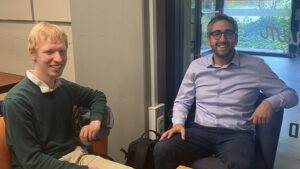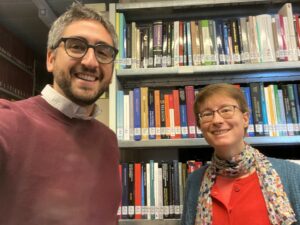From Ancient Texts to Modern Tools: Elia Scapini’s TNA Fellowship at KU Leuven
Elia Scapini, PhD student at the Università di Modena e Reggio Emilia and researcher in the ITSERR project, recently completed a two-week RESILIENCE Transnational Access (TNA) fellowship at KU Leuven. His work combines historical research with machine learning, focusing on semantic sentence retrieval in Ancient Greek and Latin texts related to the early Arian controversy, from Eusebius of Caesarea to Eustathius of Antioch.
During his stay, Elia deepened his study of the Eustathian corpus in relation to other early Arian sources. The fellowship also supported the refinement and implementation of a multilingual retrieval tool for Ancient Greek and Latin, contributing both to his doctoral research and to the development of more advanced infrastructures for scholars working with historical religious texts.
We asked Elia about his experiences:
What motivated you to apply for the RESILIENCE fellowship at KU Leuven, and what were your expectations?
My main motivation was the opportunity to meet leading scholars in the field of Natural Language Processing (NLP). I hoped to discuss with experts who work on applying Large Language Models (LLMs) to ancient languages, particularly Latin and Greek, and to explore advanced methods and approaches for specialised datasets.
I was also eager to exchange ideas with historians and theologians studying the early Arian controversy and the key figures involved in the debates surrounding the Council of Nicaea. Finally, this fellowship offered the chance to present and disseminate some of the results from my work in the ITSERR project, in which I am directly involved. My expectations of the exchanges and networking possibilities during my TNA stay were completely fulfilled.
During your stay at KU Leuven, what tools, methods, or collaborations did you find most inspiring?
One of the most stimulating meetings was with Prof. Margherita Fantoli and her PhD students, Laura Soffiantini and Marijke Beersmans. We discussed the outcomes of the ITSERR project and identified several promising connections. Following our meeting, Margherita kindly agreed to serve as a reviewer for a deliverable on ITSERR’s technological outputs.
Together, we explored the retrieval mechanisms implemented in our soon-to-be released tool on the RESILIENCE Marketplace. In turn, they shared their ongoing work on Named Entity Recognition in ancient texts. I also provided them with a German version of SPhilBERTa, a model I fine-tuned using the SimCSE technique, which may support their research on identifying names and entities in Greek and Latin literature.
Another highly valuable exchange took place with Dr. Alek Keersmaekers, whose expertise in digital humanities and computational approaches to Greek texts offered new perspectives and inspiration for my own work.

What future possibilities or collaborations emerged from this fellowship that could benefit the RESILIENCE community and beyond?
A TNA fellowship is an invaluable opportunity to build connections and exchange ideas with researchers who share similar interests, even if not all meetings lead to formal collaborations. During my stay, I attended a lecture by Elizabeth De Palma Digeser (University of California, Santa Barbara) on “Echoes of Irenaeus in Late Ancient Gaul”, which offered fascinating insights into the early Christian presence in Gaul at the beginning of the IV century and its connections with Irenaeus of Lyon.
I also visited Louvain-la-Neuve, where I met Prof. Marie Pauliat, a scholar of Augustine, and her PhD student, who is studying female figures and gender perspectives in Augustine’s works. These conversations opened new avenues of reflection for both sides.
Although a planned meeting with Prof. Johan Leemans had to be rescheduled, we managed to speak informally during a lunch break. I was also pleased to learn more about Giorgio Millesimi’s research on the relationship between Catholicism and LGBT issues, which provided thought-provoking insights into contemporary theological debates.

Which research projects are you involved in that incorporate your outcomes?
I am part of the ITSERR project (Italian Strengthening of the ESFRI RI RESILIENCE), working within Work Package 4 – DaMSym (Data Mining: the Nicene-Constantinopolitan Symbol). This unit focuses on the semantic analysis of key terms in the Nicene-Constantinopolitan Creed and its various translations.
The goal is to advance understanding of theological language through new computational tools based on Large Language Models (LLMs) that assist scholars in exploring meaning and translation patterns across historical Christian texts.
Another research unit I am involved is the FSCIRE Research Group on the Nicene-Constantinopolitan Creed, hosted by FSCIRE (Fondazione per le Scienze Religiose – Bologna), was established in preparation for the 1700th anniversary of the Council of Nicaea (325–2025). The project investigates the historical formation of the Creed, its Constantinopolitan reworking, and its numerous translations from Greek and Latin to Armenian, Syriac, Coptic, Arabic, and Slavonic.
The group combines historical, theological, philological, and linguistic approaches to study how the Creed was received and reinterpreted across centuries and languages, tracing both its doctrinal evolution and its cultural adaptations.
I am also a doctoral student in DREST (Dottorato di Interesse Nazionale in Studi Religiosi), a national PhD programme coordinated by Prof. Alberto Melloni. It brings together universities and research centers across Italy to foster advanced scholarship in religious studies.
The programme promotes interdisciplinary training through six main curricula: Christianity, Islam, Judaism, Buddhism and Asian religions, Law and Religion, and Technological Frontiers. It aims to build a new generation of scholars equipped to interpret the enduring influence of religious traditions in contemporary societies.
Many thanks for the interview, Elia! We wish you continued success with your research.
***
Visuals: Elia Scapini with with Prof. Margherita Fantoli, Laura Soffiantini and Marijke Beersmans (top image from right to left), with Dr. Alek Keersmaekers (second image) and with Prof. Marie Pauliat (below).